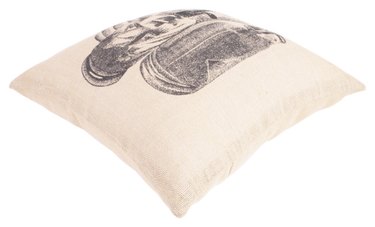Things You'll Need
Wood
120-grit sandpaper
Clear acrylic sealer
Paintbrushes
Water-soluble or acrylic ink
Newspapers
Pencil
Mesh screen in frame
Drawing fluid
Wooden blocks
Screen filler
Squeegee

Screen printing is also known as silk screening, and is a traditional image transfer process that has been used by artisans for centuries. Screen printing duplicates a design on the surface of an object, most commonly on textiles. You can screen print onto other surfaces, such as plastic or wood. Although most screen printing today is done by machine, you can learn to make your own prints at home.
Step 1
Prepare your wood surface by sanding it down until smooth. If you do not want the grain of the wood to show through the ink, coat the wood with a clear acrylic sealer. Let the sealer dry completely. If you've used a thick layer of sealer, sand with 120-grit sandpaper to smooth the surface.
Video of the Day
Step 2
Cover your workspace with newspapers and begin preparing your mesh screen. Draw your design directly on the screen in pencil. If you want to trace an image, simply lay the mesh on top of your image and trace the image onto the mesh.
Step 3
Open a bottle of drawing fluid and paint it directly onto the screen, covering only the parts of the design that you want transferred to the wood. This includes all the space inside your drawn lines. Let the drawing fluid dry.
Step 4
Elevate the screen on the table so that the mesh does not touch the newspaper. Use a few magazines or books, and make sure the screen is at least 1/4 inch away from the table.
Step 5
Pour screen filler into one end of the screen. Drag the puddle of filler across the screen with a squeegee, coating the entire image. Let the screen filler dry.
Step 6
Rinse the screen out in the sink, so that all the drawing fluid washes off. This will leave you with a stencil of your design. Let the screen dry.
Step 7
Pour a water-soluble or acrylic ink into one end of the screen. Drag the puddle of ink across the screen with a squeegee, as you did in Step 5.
Step 8
Elevate the screen 1/4 inch over your piece of wood. Drag the squeegee across the screen again, this time transferring the ink to the wood. If you're having trouble keeping the screen from sliding around while you work, you can secure the screen's frame to the work table with frame hinge clamps.
Step 9
Remove the screen carefully from the wood. Let the wood dry completely, and rinse the paint out of the screen to use again.
Tip
You can purchase mesh screens and frame hinge clamps at any art supply store. To print on pre-painted wood, first coat the wood with gesso. You may have difficulty getting the ink to stick, otherwise.
Video of the Day